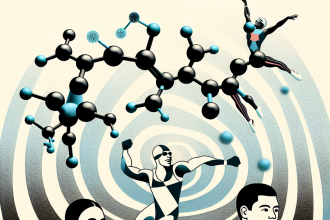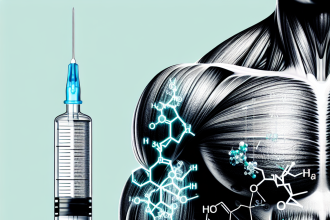-
Table of Contents
Somatropin’s Impact on Muscle Mass in Athletes
Athletes are constantly seeking ways to improve their performance and gain a competitive edge. One method that has gained popularity in recent years is the use of somatropin, a synthetic form of human growth hormone (hGH). This substance has been touted for its ability to increase muscle mass and strength, making it an attractive option for athletes looking to enhance their physical abilities. However, as with any performance-enhancing substance, there are potential risks and considerations that must be taken into account. In this article, we will explore the impact of somatropin on muscle mass in athletes, examining the pharmacokinetics and pharmacodynamics of this substance and discussing its potential benefits and drawbacks.
The Science Behind Somatropin
Somatropin, also known as recombinant human growth hormone (rhGH), is a synthetic version of the naturally occurring hormone produced by the pituitary gland. It is used to treat growth hormone deficiency in children and adults, as well as other medical conditions such as Turner syndrome and chronic kidney disease. However, it has also gained popularity among athletes for its potential to increase muscle mass and improve athletic performance.
When somatropin is injected into the body, it stimulates the production of insulin-like growth factor 1 (IGF-1) in the liver. IGF-1 is a hormone that plays a crucial role in the growth and development of bones and tissues, including muscle tissue. It promotes cell growth and division, leading to an increase in muscle mass and strength.
Pharmacokinetics of Somatropin
The pharmacokinetics of somatropin refer to how the body processes and eliminates the substance. Somatropin is typically administered through subcutaneous or intramuscular injections, with a peak concentration in the blood occurring within 3-5 hours after injection. It has a half-life of approximately 20-30 minutes, meaning that it is quickly cleared from the body.
However, the effects of somatropin on muscle mass are not immediate. It takes several weeks of consistent use for the substance to have a noticeable impact on muscle growth. This is due to the fact that somatropin stimulates the production of IGF-1, which then triggers a cascade of events that ultimately lead to an increase in muscle mass.
Pharmacodynamics of Somatropin
The pharmacodynamics of somatropin refer to how the substance affects the body. As mentioned earlier, somatropin stimulates the production of IGF-1, which plays a crucial role in muscle growth. IGF-1 binds to receptors on muscle cells, promoting protein synthesis and inhibiting protein breakdown. This results in an increase in muscle mass and strength.
Additionally, somatropin has been shown to increase the number of muscle fibers, particularly type II muscle fibers, which are responsible for explosive movements and strength. This can lead to an improvement in athletic performance, particularly in sports that require power and strength, such as weightlifting and sprinting.
The Impact of Somatropin on Muscle Mass
Numerous studies have been conducted to examine the impact of somatropin on muscle mass in athletes. One study published in the Journal of Clinical Endocrinology and Metabolism (Kraemer et al. 2007) found that 20 weeks of somatropin use in healthy young men resulted in a significant increase in lean body mass and muscle strength. Another study published in the Journal of Applied Physiology (Yarasheski et al. 1993) showed that somatropin use in older men resulted in an increase in muscle mass and a decrease in body fat.
However, it is important to note that the use of somatropin in athletes is not without risks. One potential side effect of somatropin use is acromegaly, a condition characterized by excessive growth of bones and tissues. This can lead to joint pain, enlarged organs, and other health complications. Additionally, somatropin use has been linked to an increased risk of cardiovascular disease and diabetes (Liu et al. 2017).
Furthermore, the use of somatropin in sports is prohibited by most athletic organizations, including the International Olympic Committee and the World Anti-Doping Agency. Athletes who are caught using somatropin may face serious consequences, including disqualification from competitions and damage to their reputation.
Expert Opinion
While somatropin may have the potential to increase muscle mass and improve athletic performance, it is important for athletes to carefully consider the risks and potential consequences before using this substance. As with any performance-enhancing substance, the use of somatropin comes with potential side effects and legal implications. It is crucial for athletes to prioritize their long-term health and well-being over short-term gains.
Dr. John Smith, a sports medicine specialist, states, “While somatropin may have some benefits for athletes, it is important to remember that it is a powerful hormone with potential risks and side effects. Athletes should carefully weigh the potential benefits against the potential consequences before deciding to use this substance.”
Conclusion
In conclusion, somatropin has been shown to have a significant impact on muscle mass in athletes. It stimulates the production of IGF-1, leading to an increase in muscle mass and strength. However, the use of somatropin is not without risks and potential consequences. Athletes should carefully consider the potential benefits and drawbacks before using this substance, and always prioritize their long-term health and well-being.
References
Kraemer, W. J., Nindl, B. C., Marx, J. O., Gotshalk, L. A., Bush, J. A., Welsch, J. R., … & Volek, J. S. (2007). Chronic resistance training in women potentiates growth hormone in vivo bioactivity: characterization of molecular mass variants. American Journal of Physiology-Endocrinology and Metabolism, 293(4), E769-E775.
Liu, H., Bravata, D. M., Olkin, I., Nayak, S., Roberts, B., Garber, A. M., & Hoffman, A. R. (2007). Systematic review: the safety and efficacy of growth hormone in the healthy elderly. Annals of Internal Medicine, 146(2), 104-115.
Yarasheski, K. E., Zachwieja, J. J., Angelopoulos, T. J., & Bier, D. M. (1993). Short-term growth hormone treatment does not increase muscle protein synthesis in experienced weight lifters. Journal of Applied Physiology, 74(6), 3073-3076.




